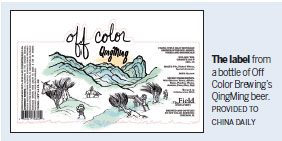
Get your 4,000-year-old beer (recipe) here.
You may not yet hear that cry at Chicago's ballparks, but you can on Thursday evening at the Field Museum on the city's Lake Shore Drive.
Off Color Brewing of Chicago will present its QingMing beer, which the museum says is "inspired by artifacts discovered during archeological digs" in Taixi and a Changzikou tomb dating from the late Shang/Western Zhou Dynasties (circa 1600-722 BC).
"We work with the Field Museum of Natural History to create archeologically inspired beers as a way to both challenge ourselves and help breathe life into the past," Off Color Brewing co-owner John Laffler told China Daily.
Laffler and co-owner Dave Bleitner of Off Color, which also supplies the museum's house beer, will be on hand to discuss how QingMing was cooked up.
QingMing draws its name from a major Chinese festival - Tomb-Sweeping Day - in which people honor their ancestors' memories - and offer some libations.
Laffler said the brewery "was particularly excited about the alcoholic beverages from this region and time as they are the first evidence of codified mold-based saccharification".
Saccharification is the conversion of rice starch to sugar and is considered China's contribution to brewing.
With a hefty 9.5 percent alcohol-by-volume make-up, QingMing is a stronger, drier, herbal version of li, a sweet rice- or millet-based beer.
"(It) falls outside generally recognized styles," Laffler said in describing QingMing. "Technically, it is an ale. The legal classification is Chang-style malt beverage brewed with rice, honey, fruits and botanicals."
Gary Feinman, the Field Museum's MacArthur curator of Mesoamerican, Central American and East Asian anthropology, assisted in QingMing's creation.

"The museum was a willing partner of these probes into history to find new flavors for beer," Feinman told China Daily. "I've been actually surveying in China for over 20 years in conjunction with colleagues from Shandong University. Early in the project, another American colleague of mine had a joint excavation with our Chinese colleagues that I was kind of peripherally involved with. In the finds from those excavations were various ceramic vessels that were tested out and revealed alcohol residues that went back over 4,000 years."
Feinman said he "took a fair amount of literature that I could find on early Chinese alcohol recipes and I sent them to him (Laffler) and he kind of mulled it over he's a creative guy and he decided which one he wanted to pursue".
"He got inspiration from some of the ingredients that had been reported in this literature as well as for the technique of using fermented rice, so those were the two inspirations that he grasped onto," Feinman said.
"Rather than a strict recreation of a single dig site, we chose to make an amalgam because existing evidence shows a wide range of beverage types were produced ... and the (US) federal government decided that many of the ingredients and flavorings being used at (that) time are not currently legal to use in beer production," Off Color's website says of QingMing.
This beer has a lot going on.
"The taste profile (of QingMing) is of peaches and lemon rind with fragrant aromas of tea, bubble gum and sake followed by an onslaught of complex fruit, herbal and floral character," says Off Color's website. "The body is dry and effervescent with the warming alcohol dissipating quickly from the palate, leaving one with the perception of nectar, honey and perfumed rice."
Feinman hasn't gotten any QingMing samples yet for his efforts.
"I'm going to be just as much an eager explorer as the people who come to the event," he said.
Contact the writer at williamhennelly@chinadailyusa.com